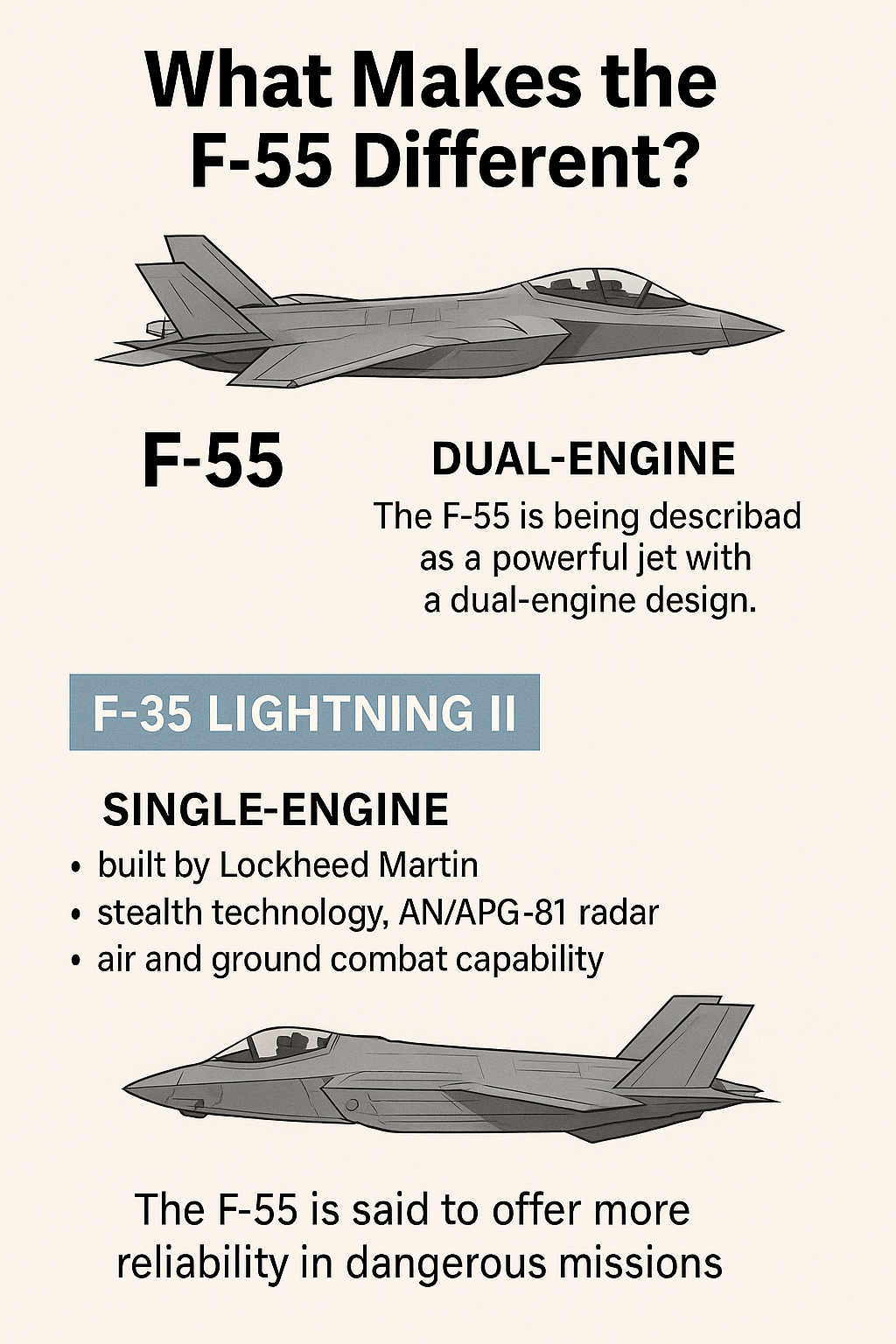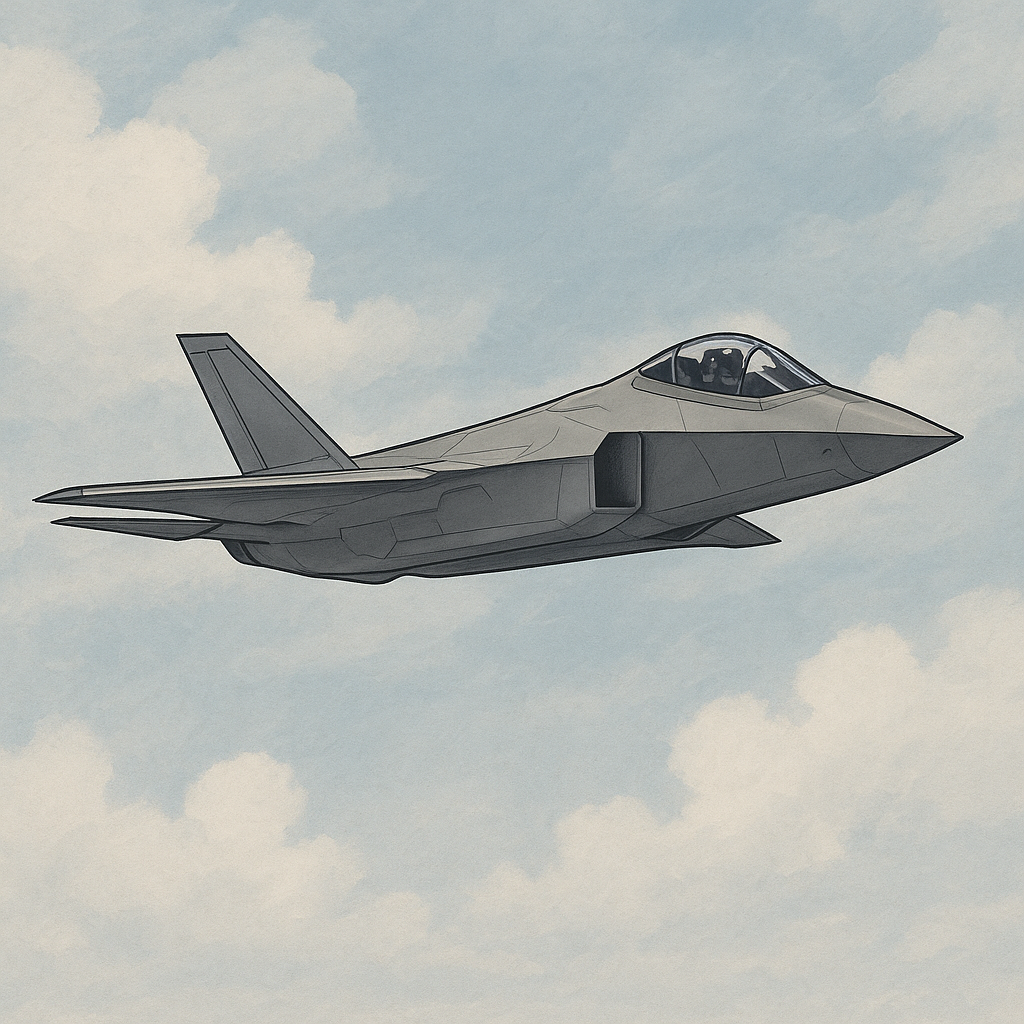A surprise announcement was made at the Al Udeid Air Base in Qatar, where former U.S. President Donald Trump revealed a new fighter aircraft named F-55. The event was attended by U.S. troops and defense industry representatives. The base, located near Doha, is one of the largest American military installations in the Middle East.
During the address, Trump spoke about the need for stronger and more advanced air power. He introduced plans for the F-55, a twin-engine stealth fighter jet, and mentioned an upgrade for the existing F-22 Raptor, which would be known as the F-22 Super. These announcements came as part of a broader defense visit across the region.
Trump highlighted that the F-55 would differ from current jets by using two engines, offering increased safety and performance. “We’re going to do an F-55,” he said, adding that it would be a step above the F-35, the current top-tier U.S. fighter jet.
Qatar also announced a $10 billion investment in the Al Udeid base and $42 billion in defense purchases, making the event significant not only for the U.S. military but also for international defense relations.
What Makes the F-55 Different?
The F-55 is being described as a powerful jet with a dual-engine design, unlike the single-engine F-35 Lightning II, which is currently in use by the U.S. and allied forces. The F-35, built by Lockheed Martin, uses just one engine (the Pratt & Whitney F135). While the F-35 is already equipped with stealth technology, radar systems like the AN/APG-81, and the ability to operate in both air and ground combat, the F-55 is said to offer more reliability in dangerous missions.
$82 Million F-35 Nearly Hit by Rebel Missile in Yemen — Deployment Sparks Scrutiny
A key point raised during the speech was that twin engines offer more safety in long-range missions, especially over contested zones like the Pacific Ocean. In areas where an engine failure could end a mission—or even risk a pilot’s life—two engines are seen as a major benefit. Trump openly criticized the single-engine design of the F-35, saying, “I don’t like single engines.”
There was no detailed explanation or official diagram shared about what the F-55 looks like or what its full capabilities are. This has led many experts to ask whether it’s a new aircraft altogether or a rebranding of existing plans like the Navy’s F/A-XX or the Air Force’s Next Generation Air Dominance (NGAD) program.
The Navy’s F/A-XX and the Air Force’s NGAD programs are both working on what is often called “sixth-generation” fighters. These future jets are expected to include stealth, drone teaming, advanced sensors, and hypersonic weapons. However, both projects are currently facing budget delays and planning challenges.

The F-22 Super and Strategic Changes
The event in Qatar wasn’t only about the F-55. Trump also mentioned plans for an upgraded version of the F-22 Raptor, one of the U.S. Air Force’s most advanced air superiority fighters. The new version, called the F-22 Super, would bring updates to an aircraft that has been flying since 2005.
F-22 Obliterates Russia’s Su-30 and Su-35 in Brutal Aerial Clash in Syrian Skies
The current F-22 is known for its twin-engine setup, stealth body, and ability to fly at supersonic speeds without using afterburners. It uses the AN/APG-77 radar system and has features that help it avoid detection. But it hasn’t seen major upgrades in recent years.
The F-22 Super could fix this by adding improved radar systems, sensors like TacIRST (an infrared sensor), and possibly weapons designed for long-distance or high-speed attacks. Other possible upgrades include stealth coatings that help avoid newer types of enemy radar.
Some of the technology planned for the NGAD program—like drone integration and advanced communication systems—may be added to the F-22 Super instead, especially since Lockheed Martin stepped back from NGAD development in 2024. Their CEO said that instead of building new planes, some of NGAD’s technology would be used to upgrade existing jets like the F-22 and F-35.
Al Udeid’s Role in the F-55 Timeline
The Al Udeid Air Base has long been a central part of U.S. military actions in the Middle East. It has supported operations in Iraq, Afghanistan, and Syria, and has been home to thousands of American troops since its creation in 1996. The base also hosts key U.S. military command structures.
Boeing Stuns Defense World with $20 Billion F-47 NGAD Win, Lockheed Falls Hard
Trump’s announcement took place on this base, highlighting its importance in testing and future deployment. Qatar’s investment in the facility—$10 billion—might go toward infrastructure upgrades, possibly allowing it to support the F-55 or F-22 Super projects in the near term.
The base previously hosted the F-22 Raptor in 2019, which was deployed to deter military threats from Iran. One incident in 2013, where an F-22 quietly forced an Iranian F-4 Phantom to retreat from a U.S. drone without firing, is often cited as proof of the Raptor’s stealth and control in combat zones.
Growing Global Competition in Fighter Jets
The announcement about the F-55 comes during a time of fast changes in the world of military aviation. Several countries, including China and Russia, are working on their own stealth fighters.
China’s J-20 jet, which became operational in 2017, uses long-range missiles and stealth designs to compete with the U.S. Air Force. A second Chinese aircraft, possibly called the J-36, is also being developed and is rumored to work alongside drones in combat.
China’s Bold J-36 Test Sends Stealthy Warning to U.S. F-47 NGAD
Russia’s Su-57 fighter jet is also being built with advanced electronics and radar, though its stealth features have been questioned by analysts. Europe is also moving forward, with the UK, Italy, and Japan working on a joint fighter program known as GCAP, and France, Germany, and Spain teaming up for FCAS.
These global developments are part of a wider race to improve air capabilities, especially in regions like the Pacific, where the U.S., China, and Russia all operate heavily.
F-47 Mention and Budget Questions
Trump also spoke about something called the F-47, though no clear information was shared about this aircraft. It’s not clear whether it is a new platform or a renamed part of the NGAD or F/A-XX programs. Boeing was linked to this new aircraft, and the company has been active in supplying both military and civilian aircraft, including recent deals with Qatar.
The costs involved in developing new fighter jets are high. One NGAD aircraft is estimated to cost over $300 million. Some defense officials, including Defense Secretary Pete Hegseth, have suggested delaying projects like F/A-XX by up to three years due to budget constraints.
Qatar’s role in helping fund U.S. defense programs, through its $42 billion defense deal, may play a part in keeping projects like the F-55 on track. These purchases are reported to include long-range armed drones, adding to the region’s security framework.
Public Reactions and Transparency Issues
While the announcements have generated interest, many experts and officials have raised questions about the lack of technical details around the F-55. Unlike the F-35 program, which went through public tests and updates, the F-55 was introduced suddenly, with few concrete facts shared.
US Deploys F-22 Raptors in South Korea
This has led to speculation that the project may be in an early planning stage, and that it could be a way to gather political support and funding for existing or future platforms.
Despite the uncertain path ahead, the F-55 remains a focus of attention among defense watchers and military professionals, especially due to its potential link to multiple current and emerging fighter programs.

